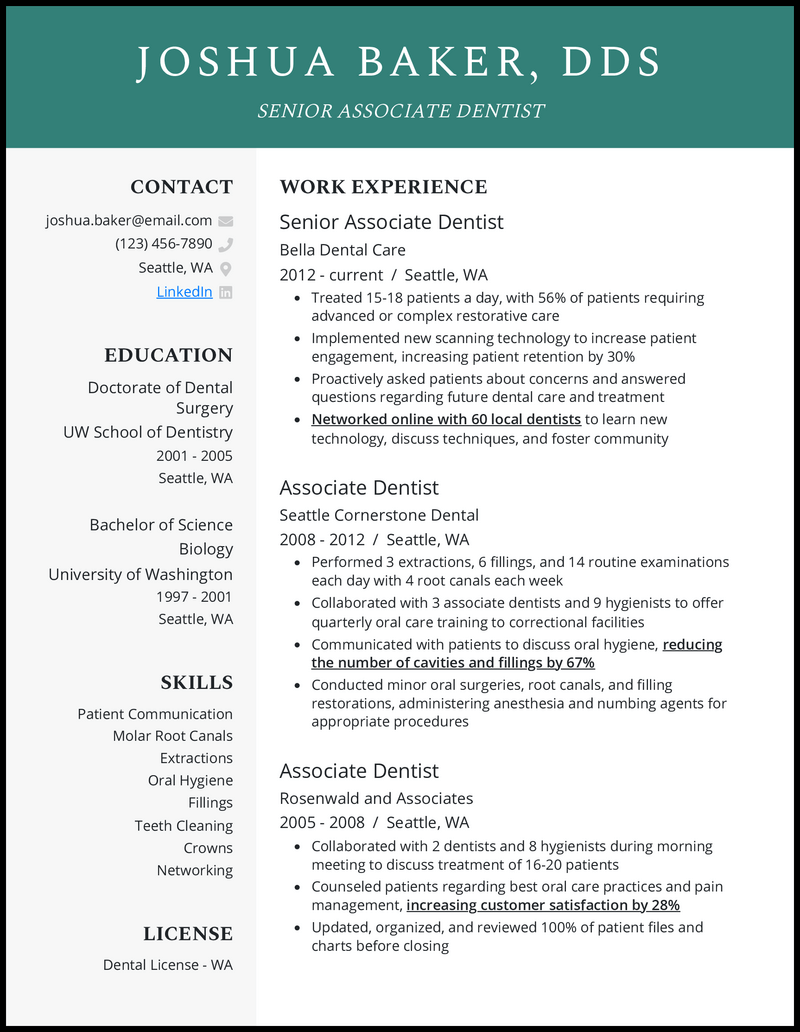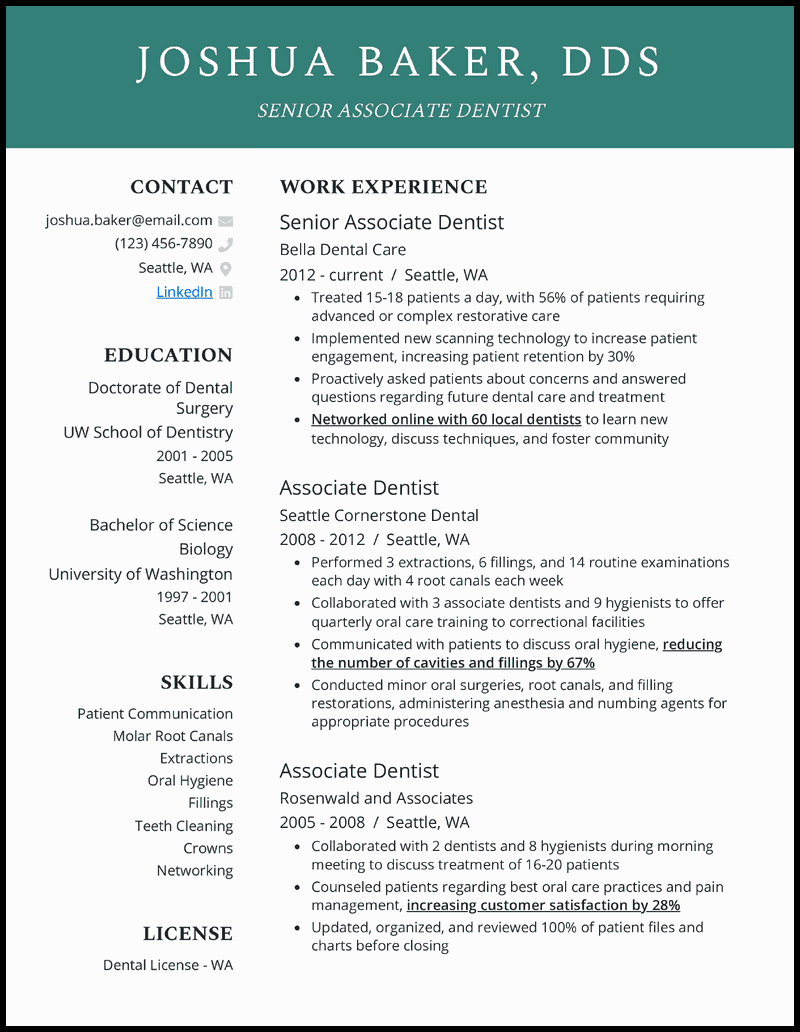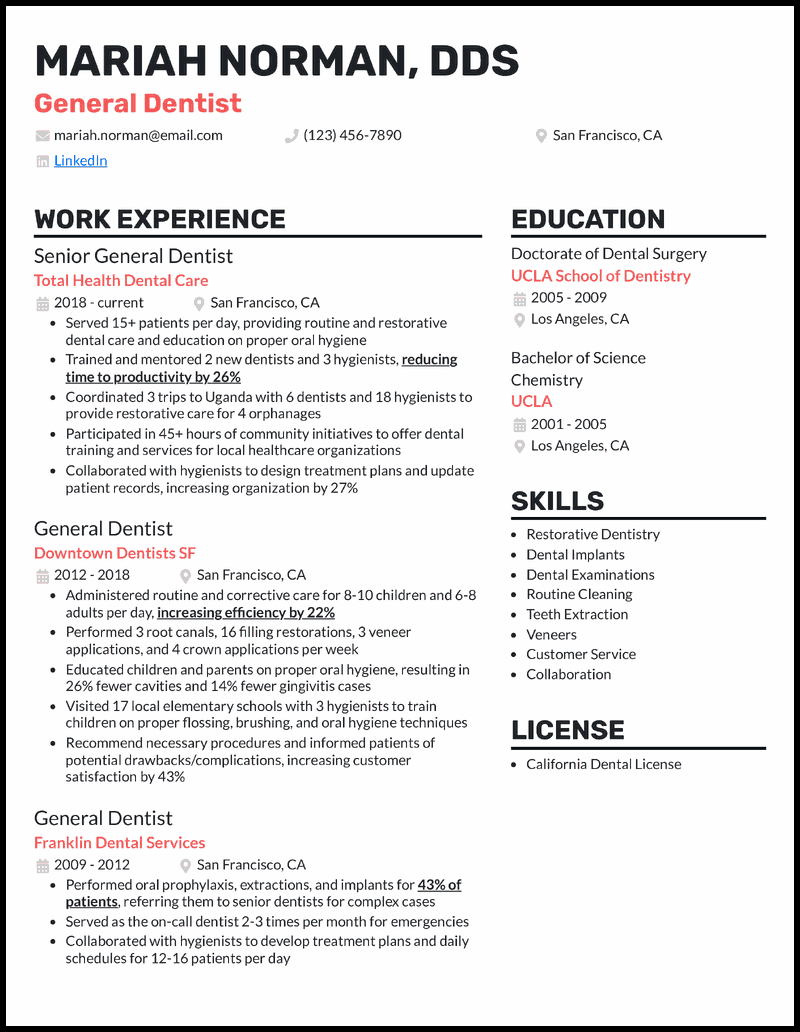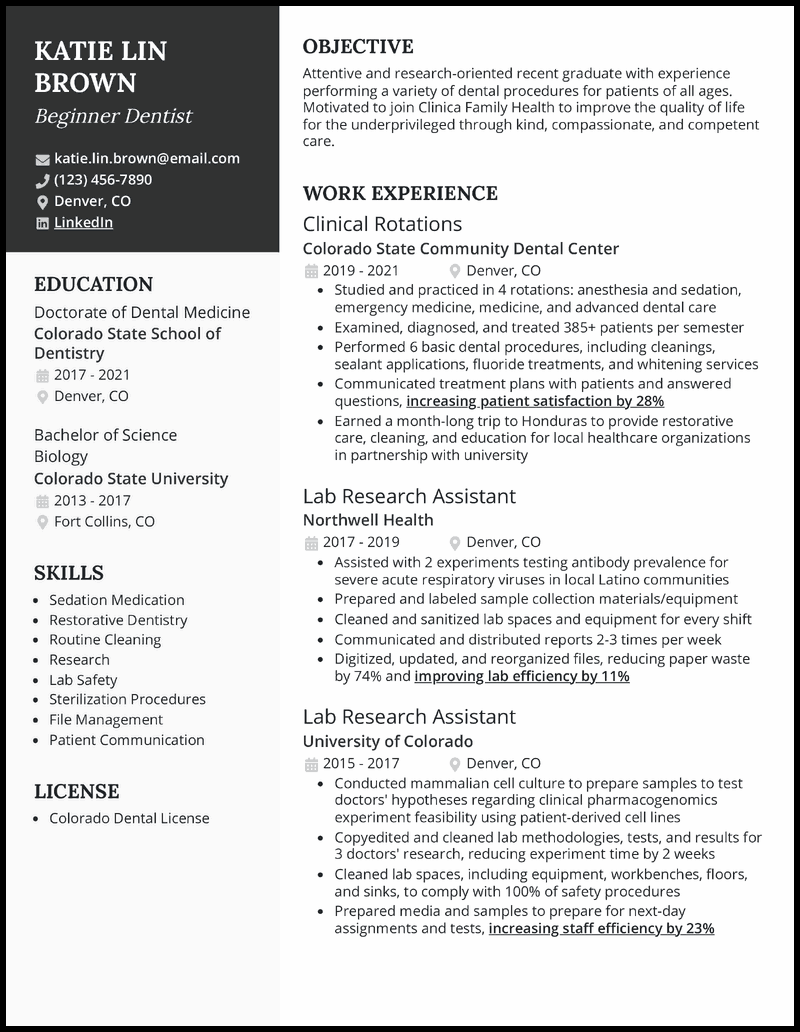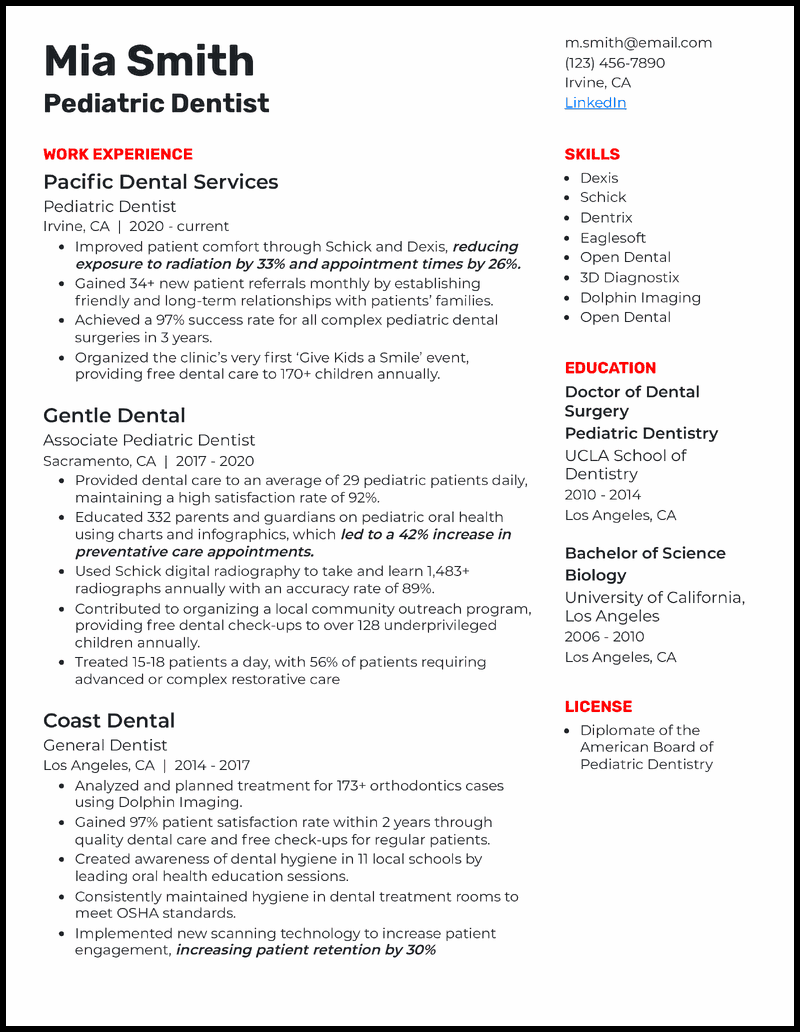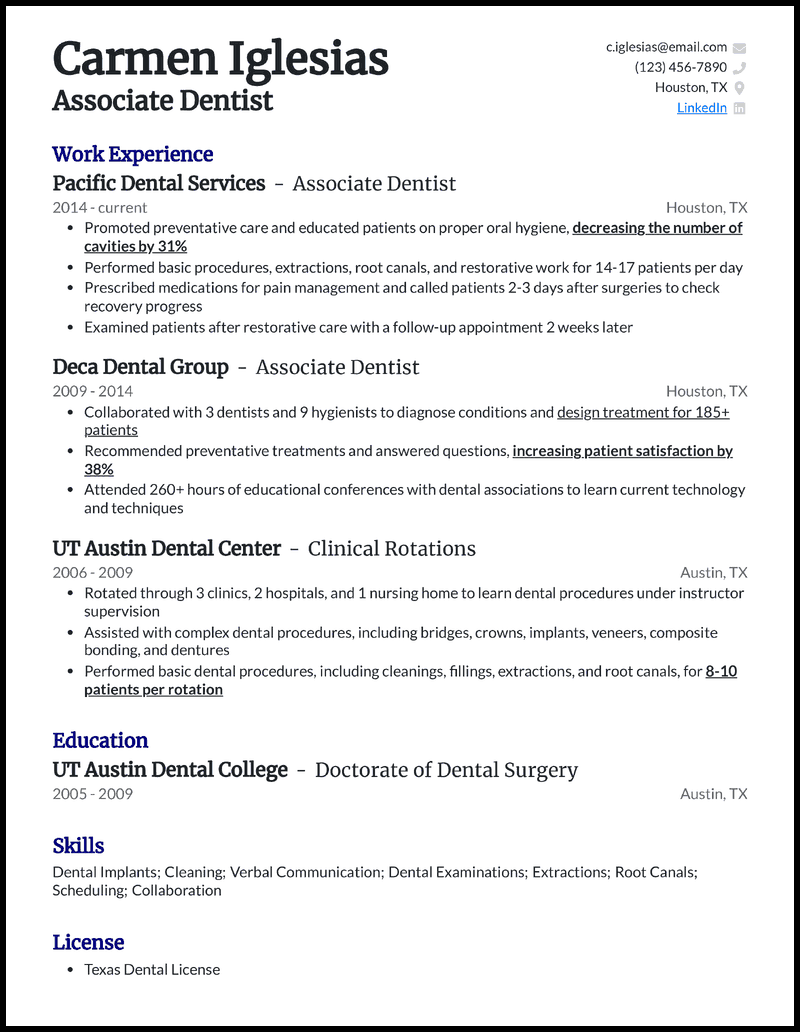Good dentists are worth their weight in gold. Your competent and steady hands go a long way toward improving people’s smiles.
Your dentist resume has the power to demonstrate your technical skills and your ability to be an empathetic advocate for your patients.
While you’re incredible in all things teeth, you might need help determining where to begin on your resume. That’s why we’re here!
We’ve done the hard work researching the good, the bad, and the ugly for all types of dentist positions and their respective resumes (such as dental hygienist resumes and dental assistant resumes). We’ve taken everything we’ve learned to design these seven dentist resume samples to help you create a resume to land your next dental job in 2025!
Quantifying always helps
- All clinics love repeat visits from patients and dental clinics are no different. So use numbers to prove you have what it takes to instill trust and bring back patients.
- Don’t just say that you’ve provided advice or used a new method to help customers, quantify their level of impact.
- For instance, instead of saying, “implemented new scanning technology in the clinic,” try something such as, “implemented new scanning technology for better patient engagement, increasing patient retention by 30% as a result”.
Make skills your ally
- In an ever-evolving field of technology, you have to show how great your hand is with the latest dental tech and tools.
- In your resume’s skills section, consider adding things like restorative dentistry, dental implants, routine examinations, etc. to confidently prove your skills are up to snuff for bright smiles and any oral hygiene need.
- Remember, patients don’t just want good dental work, but a good overall experience. So, go beyond technical skills and include a few care-oriented skills like anxiety management or patient communication.
Emphasizing education
- For recent graduates, it’s good to emphasize education and give it the spotlight while formatting.
- Add your latest and most relevant dental degree. A high GPA score, anything 3.75 or up is a welcome addition, too.
- If possible, try mentioning coursework like Oral Anatomy & Physiology, Clinical Practice of Operative Dentistry and Endodontics, Pediatric Patient Management and Clinical Practice and General Dentistry to prove you’re all ready for the role.
Add a career objective
- A resume objective or career objective is a great way to highlight your best bits at the very start.
- Employers won’t always have the patience to go through every resume. Therefore, mentioning your strong points and goals will give them a clear picture of your profile immediately.
- Don’t forget to tailor it to the clinic you’re applying to and the job description. Example: “Research-oriented dentist with experience in various surgical practices like implants and bone grafting looking to join XYZ clinic”.
Show career growth
- You don’t automatically reach a higher level of dental practice without excelling at previous clinics you’ve worked in.
- Instead of focusing entirely on your current role, hint at your past by using a reverse chronological resume format. This will show how you’ve moved up the ranks of dentistry over the years of your career.
- Include lower rank jobs like Associate Dentist at the bottom and higher roles like Senior Dentist at the top.
Earn trust with a license
- If there’s one thing recruiters can’t afford to overlook—it’s a recognized dentist license.
- Listing certifications will boost your credibility. Include the certification(s) the job description requires or prefers, such as a Diplomate of the American Board of Pediatric Dentistry Registered Dental Assistant, or Certified Dental Technician certification.
- It’s a good idea to add your state-specific license to prove that you’re a seasoned dentist/periodontist that the locals can rely on.
Let metrics do the talking
- Clinic recruiters know that they can’t hire any dentist from down the street, so the best way to prove your worth is by including hard-hitting metrics.
- Did your advice to patients help reduce cavity cases? How many design treatments were you a part of? What was your role in improving a clinic’s patient satisfaction rate?
- For example, try something like: “Educated patients on proper oral hygiene and preventive care, decreasing the number of cavities by 27%.”
Related resume guides
Create a Tailored Dentist Resume Based on the Job Description

As a dentist, you need to plan for every patient’s unique circumstances. Some may need help with periodontal issues, while others struggle with an overbite. Plus, you have to understand your patients’ lifestyle factors.
Like every dental issue requires a tailored approach to patient needs, your resume will require a similar touch. The best place to start will be reviewing the job description. That way, whether the office focuses on cosmetic procedures or traditional cleanings, you can list the right skills for the job.
Need some ideas?
15 popular dentist skills
- Patient relations
- Root canals
- Tooth cleanings
- Fillings
- Extractions
- Crowns
- Restorative dentistry
- Dentrix
- Eaglesoft
- X-rays
- Lab safety
- Sedation medication
- Sterilization
- File management
- 3Shape TRIOS

Your dentist work experience bullet points
When patients choose a dentist, they’ll want to know they’ll get the desired results from visiting your office. That’s why dental hiring managers put extra time and consideration into the specific work achievements you list on your resume.
A great way to stand out is going above just listing job duties like routine examinations and root canals. Instead, aim for actionable one-sentence descriptions using metrics like how you boosted patient satisfaction rates or provided guidelines that helped reduce receding gums by 45 percent.
Here are some great metrics you can add to make your dental resume stand out.
- Success rate: When you prescribe a treatment or procedure, is it successful? Any time you can share positive results, it’ll make you stand out as a dentist.
- Patient retention: Patients continuously coming back to the same dental office is a great sign that you and your team were doing something right to create an excellent experience.
- Accuracy: Great dentists can manage data and identify oral health problems accurately before they become a major issue.
- Safety scores: Dental offices must operate precisely, so any impact you can make on sanitization and procedural safety scores will stand out.
See what we mean?
- Educated 332 parents and guardians on pediatric oral health using charts and infographics, which led to a 42% increase in preventative care appointments.
- Consistently maintained a 94% on-time schedule rate for daytime visits using the Open Dental platform for appointment management.
- Digitized, updated, and reorganized files, reducing paper waste by 74% and improving lab efficiency by 11%.
- Implemented new scanning technology to increase patient engagement, increasing patient retention by 30%.
9 active verbs to start your dentist work experience bullet points
- Treated
- Applied
- Corrected
- Implemented
- Optimized
- Performed
- Prescribed
- Examined
- Recommended
3 Ways to Bolster Your Dentist Resume When You Lack Experience
- Reference educational achievements
- You’ve completed rigorous education to obtain your DDS or DMD, so any achievements you had along the way can be included on your resume to show you have the necessary skills. For instance, you could write about passing an embryology exam involving identifying oral tissues accurately to get a 98 percent overall grade.
- Use a resume objective
- A good resume objective is a great way for inexperienced dentists to immediately present some top skills and career goals. For example, you could write a couple of sentences about how you’re a passionate dental professional and are eager to apply your patient-first mindset to create a great experience when performing restorative procedures.
- Include internships or residencies
- Internships or residencies you’ve completed are also valuable experiences that will help you show your skills at the early stages of your career. For example, you could talk about assisting in root canals or applying lab safety procedures to maintain operational compliance.
3 Tips to Shine Up Your Dentist Resume When You Have Experience
- Consider adding a resume summary
- When you have ten or more years of dentistry experience, a summary statement can help you emphasize key achievements and skills that make you stand out. For instance, you could write a few sentences about how you’ve placed over 500 implants and bridges in your 12-year career with a 99% success rate.
- Keep it on a single page
- Hiring managers in busy dental offices need to review resumes quickly to narrow down which candidates they choose to call for an interview. So, keep it on a single page and narrow in on the needs of each dental office, like teeth whitenings and veneers for a dental office that focuses on cosmetic procedures.
- Remove any irrelevant jobs
- You’ve grown a lot as a dentist since you started your career at initial internships or residencies. If you have lots of experience, you can remove those early-stage jobs to emphasize your most relevant skills in restorative procedures and cleanings.

How to write a dentist resume
- Start with a summary or career objective of your dental career
Accomplished and seasoned dentists, you can take advantage of a summary statement by highlighting your greatest career accomplishments, like pediatric care where your work impacted the oral hygiene in children, families, and schools. If you’re just starting your dentistry career, your objective can assure employers you’re skilled and ready to meet the specific challenges of the clinic, like improving the quality of life for the underprivileged. Alternatively, skip this section if you’re in a hurry.
- Talk about your dental career in order
Recount your experience in reverse-chronological order in your dentist resume. For example, the top third of your resume might contain your senior dentist role where you not only served patients daily in minor oral surgeries, extractions, and exams but mentored other dentists, coordinated international trips to initiate dentistry programs, led presentations at conferences and community programs. Clinical rotations and associate dentistry roles are better saved for the bottom two-thirds of your resume.
- Use numbers when describing your dentist experience
Quantify your impact in dentistry for a winning dentist cover letter and resume. Was patient education your passion? If so, did you see a decrease in cavities or gingivitis in your pediatric population? Or, maybe you worked to implement new technologies that increased the accuracy of diagnosing oral disease. By how much did this technology increase the accuracy of diagnosis, and how did this affect your treatment and education plans for the patient?
- Choose your dentist skills wisely
No dental position is the same. Strategically pick skills to include on your dental resume by first thinking about the skills you possess and then matching those skills to what you see in a business’ job description. One clinic may focus on disease prevention for underserved geriatric populations while another primarily cares for families. So, skills in sedation, preventative dental education, and extractions might be appropriate for a clinic focused on disease prevention.
- List your dental education
Include your dental accreditation and education, so employers can quickly assess your qualifications. Whether you earned a DDS (Doctor of Dental Surgery) or a DMD (Doctor of Medicine in Dentistry), this degree with the year earned and the institution should come first in your education section. Undergraduate work can follow. If you just finished dental school, consider adding awards and recognition, such as the inaugural Dr. Jeanne Craig Sinkford Student Leadership Award.
- Add your dental license to practice
List your dental licenses in a small section beneath your education and skills. Include your state dental license as well as any other required certifications and licenses, such as a CPR certification or DEA license.
Dentist FAQs

You should customize your resume to the needs of each job you apply to. It’ll help you stand out when one office focuses on periodontics and another specializes in endodontics. That way, you can present relevant abilities for each one that catches a hiring manager’s attention.
Aim to keep your dental resume to three or four jobs. To stand out, choose positions that are the most recent and relevant to list on your resume. For instance, if you’re applying to a pediatric dental office, previous experiences and achievements helping children with preventative dental care would be great to emphasize throughout.
Then, harness the power of your greatest achievements in your resume by expounding on the how and why behind the success for the key to writing a great cover letter.
Action words like “monitored” and “treated” are a way to write in an active voice and make your dental experiences sound more engaging. It makes a big difference when you can say you “treated over 100 patients with early-stage gingivitis, resulting in a 90% average reduction in symptoms” compared to saying you “know how to treat gingivitis.”




